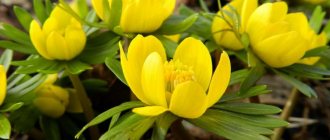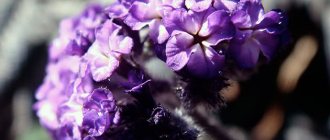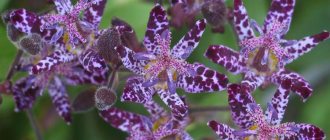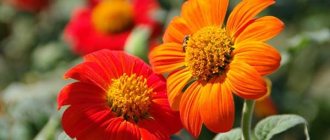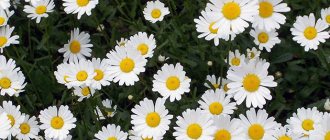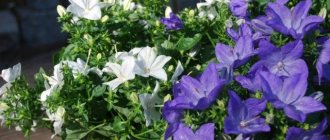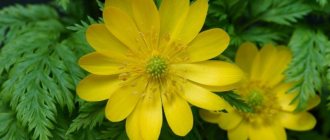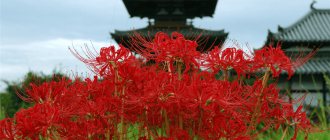Is it possible to plant in open ground - care rules
Beginner gardeners often worry whether they can plant campanula outside or not? Natural species are not capricious and frost-resistant, suitable for growing in the garden and personal plot. Cultivated varieties are more demanding in care. Outdoor campanula can be planted and replanted in spring and autumn.
The soil
Campanula in open ground prefers loamy, slightly alkaline or neutral soil. Too wet soil is detrimental to the flower. If groundwater is located close to the surface, it is advisable to plant the bell on a hill.
Reducing soil acidity is quite simple; just add wood ash. Sandy soil is mixed with humus, and clay soil with sand or peat.
Feeding perennial bluebells
Feed the plant every 14 days during active flowering. Ornamental varieties need fertilizer two or three times a month. In spring, nitrogen-containing fertilizers are applied to the soil. During the budding period, mineral complex fertilizers are used. Before flowering itself, potassium or phosphate fertilizers are added to the soil. In the fall, after the inflorescences have faded, the plant is fed with potassium and superphosphate.
Important! It is forbidden to fertilize the plant with fresh manure, after which the roots begin to rot.
Loosening and weeding
In the summer, campanula at the dacha needs regular weeding. Weeds not only worsen the appearance of the site, but also harm the plant. Weeds are the habitat of many pests and insects that infect bushes and negatively affect the development of the plant. After weeding, you should water the bushes and loosen the soil under them. This process provides oxygen to the root system.
Loosening and weeding
Location and lighting
In nature, Campanula prefers well-lit places, as well as partial shade. The ideal place for planting would be the eastern or western part of the site. Direct sunlight can cause burns on the leaves. It is advisable to shade the bushes at lunchtime. In the fall, before planting the plant in the ground, the area must be dug up and organic matter added.
Pruning and wintering
After the last inflorescence has faded, the bell must be trimmed. The process removes long shoots. Then the dry inflorescences are cut off, this has a positive effect on the formation of new buds. Then mulching is carried out with peat, the root zone is insulated with dry leaves. In spring, the shelter is removed, otherwise the flower may escape. Pruning is carried out in early spring, the dried parts of the plant are removed.
Pest and disease control
Carpathian bellflower is a plant that is quite resistant to various diseases and pests. Usually a flower gets sick if the rules for caring for it are not followed or if it is grown in the wrong place.
If you grow a bell for several years in one bed without replanting, the plants are likely to become infected with fungal pathologies. To avoid this misfortune, you should spray the flower bed with Fundazol in spring and autumn.
If you grow a flower in conditions of high humidity, the plant may become infected with slobbering frog. This disease is not dangerous and can be easily eliminated with garlic tincture.
Sometimes the foliage of plants is affected by rust, forming unsightly brownish-brown spots on the greenery. Medicines containing copper will help get rid of the problem. And in order to initially avoid rust disease, you should spray the bell plantings in the spring with solutions of Fitosporin or the drug “Gumi”.
The most dangerous pests are snails and slugs. To cope with these insects, you should spray the bells with Meta and Thunder.
The Carpathian bell is a very delicate, exquisite, but not too picky flower to care for. These features make the plant a favorite of many gardeners and allow it to be used in various design landscape projects.
Bellflower: plant propagation
Campanula can be propagated by seedlings, dividing the bush or cuttings. Terry or semi-double varieties are obtained only by vegetative methods, if the goal is to preserve the properties of the mother plant. The beginning of summer is the optimal time for propagation by cuttings. It will take them about 1 month to settle down in a new place. and minimal care:
- cut off an annual flowering shoot from an adult healthy plant;
- plant in loose soil;
- shade the cuttings.
Even a novice gardener can cope with the propagation of Campanula.
Reproduction by division is planned for late spring or summer. The plant is removed and several parts are formed from it. Each should have aboveground and underground parts, as well as several growth buds. After this, the divisions are immediately planted in open ground.
To properly collect the seeds, wait until the capsule ripens to a dark brown color. Then proceed like this:
- dry the seeds;
- in October, plant them in open ground and sprinkle with a thin layer of soil;
- water if the soil is dry.
With proper care, you will see seedlings in April-May. They are planted in a permanent place in June or July. Seedlings can also be obtained at home:
- find a wide container, because the root of the plant is quite large;
- Plant the seeds after watering the soil in the pot;
- do not deepen the planting material, but scatter it evenly over the surface;
- build a mini-greenhouse;
- once a day, open it for 15 minutes, ventilate and spray the greens with a spray bottle;
- for open ground, seedlings will get stronger in about 20 days.
Care, fertilization and wintering
The Carpathian bell is completely unpretentious. It is able to perfectly adapt to different climatic conditions, and therefore this plant does not need any special care. To successfully grow campanula, it is enough to follow a few rules:
- The flower does not need regular watering, especially if the summer period is rainy. If the summer is dry, then up to 10 liters of water must be poured under one plant bush. After each watering, the soil around the bell needs to be loosened to ensure oxygen supply to the roots.
- The plant should be fertilized twice a season. In early spring, before the snow begins to melt, nitrogen fertilizers are applied to the soil. Then, during bud setting, fertilizing with mineral fertilizers is carried out.
- The soil in which campanula grows must certainly be loose and permeable. This is facilitated by regular weeding. If the summer period is dry, then to prevent moisture evaporation, the ground around the bush is mulched with dry grass.
- Faded bellflower inflorescences must be removed regularly. This will not only allow new inflorescences to grow freely, but will also prevent self-seeding.
- To propagate the bell by seed, you need to collect seed. To do this, faded inflorescences are left on the plant so that they form fruits with seeds. The capsule-shaped fruits are harvested as soon as they acquire a dark shade and begin to open. The boxes are then left in the shade to dry. The seeds should be stored in a dry place, wrapped in paper, or they can be used in the fall for planting in open ground. It should be noted that a plant grown from seeds will bloom only in the third year.
- The Carpathian bell is hardy and frost-resistant. In the south and central Russia, it does not need shelter for the winter. But in the north or when a frosty winter is predicted, it is better to cover the bush well. To do this, all shoots should be cut off at the root and covered with a layer of fallen leaves, dry grass or spruce branches.
Garden flowers similar to daisies: what they are called and what they are like
Caring for bells in the open ground
Rules of care
They must be grown in the same way as other flowers in the garden. Bells are distinguished by their unpretentiousness. Watering is carried out only in case of a long dry and hot period. It is recommended to loosen the soil surface and remove weeds after watering. If necessary, tall varieties can be tied to a support. The first feeding is carried out in spring on melted snow and nitrogen fertilizer is used for this. The second time is fed in the first half of the summer, when buds begin to form and for this purpose complex fertilizer is used. Regular removal of fading flowers will make the flowering period longer.
Reproduction of bluebells
Annual plants can be propagated only by seeds, and biennial plants by seeds, as well as by cuttings in the spring. Bells, which are perennials, are propagated by parts of rhizomes, stolons, root cuttings, and also by dividing the bush. Seeds of perennial species may not retain varietal characteristics. In terry varieties, seeds do not appear at all and only the vegetative method is used for propagation.
Those perennials that have a taproot or carpal root system are vegetatively immobile and are grown exclusively from seeds. Species with a short rhizome are classified as vegetatively inactive, and cuttings and division are used for their propagation. Species that have creeping long rhizomes are considered vegetatively mobile, and for their propagation they use seeds, cuttings, rhizome segments, root suckers, and you can also divide the bush.
Sowing seeds for seedlings is described above. They can also be sown in open soil in mid-October. In winter, they will not freeze out, but will undergo a completely natural stratification. In spring, you will see dense shoots. After the plants grow, they will need to be replanted. Sowing seeds in open soil can also be done in May. But in this case, the seeds will need preparation, or rather, stratification in the refrigerator (in the vegetable drawer), where they should stay for 8 weeks. However, annuals reproduce well by self-sowing, and therefore the difficulties associated with spring sowing can be completely avoided.
Cuttings are harvested in spring. So, in March or April they should be cut from young stem or basal stems. Loose and light soil is used for planting. The cuttings are covered with a transparent film so that they are kept in high humidity all the time. The ideal option for rooting cuttings would be a greenhouse that has a mist sprayer. After 3-4 weeks, the cuttings should take root.
As a rule, bushes that are older than 3–5 years are used for division. But there are species that are suitable for division already in the second year of life. Large bushes should be dug up in the first days of May or at the end of the summer. All shoots are cut off, and then the rhizome is divided into parts using a very sharp, pre-sterilized knife. Make sure that each cutting contains renewal buds and well-developed roots. The cuttings must be treated with crushed charcoal, and after that the cuttings must be immediately planted in a permanent place.
In order to propagate by parts of the roots, you need to dig up the creeping rhizome and cut it into parts. Please note that each such division must have a renewal bud. Then they are planted in the soil so that the buds are at the level of the soil surface.
The root shoot, separated from the mother plant, is immediately planted in a permanent place.
Pests and diseases
Bells have a very beautiful appearance, and they are distinguished by their unpretentiousness. These plants are highly resistant to diseases and harmful insects and get sick in very rare cases. But if perennials are grown for a long time without replanting, then an accumulation of pathogenic microorganisms (sclerotinia, fusarium or botrytis) can occur in the soil, which can completely destroy the bells. In order to avoid this, it is necessary to carry out one treatment of plants with a solution of Fundazol (0.2%) in the spring and autumn.
The slobbering frog may appear on bushes in wet weather. Infected plants are treated with garlic infusion. Low-growing species may be damaged by slugs. In this case, the treatment is carried out with a decoction of hot pepper, and granulated superphosphate must be scattered over the surface of the soil.
Pest and disease control
Carpathian bellflower is a plant that is quite resistant to various diseases and pests. Usually a flower gets sick if the rules for caring for it are not followed or if it is grown in the wrong place.
If you grow a bell for several years in one bed without replanting, the plants are likely to become infected with fungal pathologies. To avoid this misfortune, you should spray the flower bed with Fundazol in spring and autumn.
If you grow a flower in conditions of high humidity, the plant may become infected with slobbering frog. This disease is not dangerous and can be easily eliminated with garlic tincture.
Sometimes the foliage of plants is affected by rust, forming unsightly brownish-brown spots on the greenery. Medicines containing copper will help get rid of the problem. And in order to initially avoid rust disease, you should spray the bell plantings in the spring with solutions of Fitosporin or the drug “Gumi”.
The most dangerous pests are snails and slugs. To cope with these insects, you should spray the bells with Meta and Thunder.
The Carpathian bell is a very delicate, exquisite, but not too picky flower to care for. These features make the plant a favorite of many gardeners and allow it to be used in various design landscape projects.
Obtaining bellflower seedlings from seeds
This method is labor-intensive and time-consuming, but allows you to get good flower sprouts even in cold regions. To obtain dense seedlings, seeds are sown in small boxes (pots can be used) with substrate. Sowing is carried out from February to the end of March.
Container for growing seedlings
First you need to prepare containers for future seedlings with a certain amount of fertile soil. If it is not possible to purchase a substrate specifically for the bell, you can prepare it yourself. To do this, mix turf, organic humus and river sand.
It is important to maintain proportions. They are equal to 6:3:1 respectively. Before planting the seed, the substrate is well moistened with water.
After this, all the seeds are scattered over the surface of the substrate and lightly patted, but this should be done without sprinkling with earth. All containers are tightly covered with oilcloth or transparent glass. After this, the boxes or pots are placed in a well-heated room with natural light. The window sill of a window facing the western or southern side of the world is best suited. To prevent the seedlings from burning, you should open the boxes for a while every day for 14 days to bring in fresh air. Additionally, the soil is moistened with water at room temperature from a spray bottle.
Carpathian bellflower seedlings
The first seedlings appear in the third week. After it sprouts with leaves, they should be planted in small containers; regular yogurt or sour cream cups will do. 2-3 plants are planted in each, then observing the watering regime. Serious drying out or excessive moisture of the soil should not be allowed. In May, all seedlings can already be planted in the ground. Additional information on growing can be found in the video.
Types, varieties
List of bellflower varieties (the color of the bells is indicated in brackets):
Gnome (light lilac).
Blue Numlight (light blue).
Torpedo (light purple).
Blue Clips (blue with a purple tint).
Pearl White (white).
Pristar (purple).
Carpathian bellflower is one of the species of the genus of bellflowers of the Campanaceae family. It no longer has subspecies. But breeders have bred several decorative varieties. They have the same appearance, flowering time and flower size. The only thing that distinguishes them is the color of the petals. Therefore, to describe the distinctive features of varieties, it is enough to simply indicate the color of the “bells”.
How and when to sow Carpathian bellflower for seedlings
Growing seedlings should begin in March. Sowing seeds superficially, under a transparent lid or glass.
Pay attention to the requirements for the location, it must be:
- light, warm, without drafts;
- with additional light, energy-saving or special phytolamps;
- with a constant temperature not lower than 20 ℃.
Watering is carried out every 10 days when the soil dries out. Shoots appear in two to three weeks. After another week, the seedlings begin to harden little by little: remove the lid first for 10-15 minutes, gradually increasing the time and bringing it up to 2 hours, and then leave it open overnight.
After the third leaf appears, the seedlings are transplanted so that the distance between them is at least 30 cm. Plan to plant the seedlings on the site at the end of May.
Advice. The plant has long roots, so it is better to grow seedlings in high pots.
Description, varieties and varieties
Carpathian bellflower (Campanula carpatica) belongs to the perennial herbaceous plants of the Campanula family. The name comes from its natural habitat - meadows and meadows of Transcarpathia, the Carpathian Mountains. Popularly, the flower is also called chenille, chebotki or bells. Campanula was discovered by the Austrian Nikolaus Jacquen, and by the end of the 18th century the plant was already decorating the royal gardens.
Carpathian bluebell (Campanula carpatica)
Campanula carpatica is a dwarf bellflower species. The height of the spherical bush does not exceed 20–30 cm. The stems are thin, branched, dark green. The leaves are egg-shaped with pointed tips. At the base of the plant, leaf plates form a rosette. The stem leaf is smaller, with short petioles.
At the end of each shoot there is one large (up to 5 cm in diameter) cup-shaped flower of blue, light blue, white or purple. Carpathian bellflower blooms from early summer to mid-autumn, alternating inflorescences. After flowering, a fruit is formed, which is a cylindrical capsule with seeds.
Campanula is represented by many varieties, but the most famous are:
- Dwarf. The bell bushes in the shape of a ball and blooms white or white-blue. Bush height – 30 cm.
- Clips. Large flowers of blue, dark blue or white look very impressive on a low-growing bush.
- Alba. It grows up to 90 cm in height and is distinguished by snow-white inflorescences in the form of clusters.
- Celestine. Dwarf campanula, not exceeding 25–30 cm in height, with bright blue flowers with a diameter of 5 cm.
- White Star. The most popular variety among gardeners. A low bush (30 cm), blooms with large white flowers.
- Chinese Service. The highlight of this variety of bells is the multi-colored inflorescences. White, pink, blue and light blue flowers can grow on one bush. Plant height – 70–80 cm.
Growing flowers from seeds
This method allows you to easily and quickly propagate elegant flowers on your site. Plants grow best in neutral, slightly alkaline soils. Flowers do not develop well in acidic soils. Therefore, clay soils are “diluted” with humus and compost at the rate of fifteen kilograms per square meter of area. If the soil is loamy, then 19 kilograms of humus are added per square meter of area.
For full growth, bells need well-lit places. Although flowers develop well in shaded areas. Bluebell "Cup and Saucer" grows beautifully under fences where soil moisture is well maintained. Therefore, it is often planted near eastern or western walls. But the flowers do not tolerate stagnant water well and in very damp areas the bells simply overheat.
Stages of growing seedlings
To quickly germinate seeds, mix turf soil, sand and humus in a ratio of 6:1:3. The soil mixture should be loose and slightly moist.
- In the last days of March, small seeds are planted in moist soil. There is no need to sprinkle the planting material with soil; you can lightly dust it with sand.
- The container with the seeds is sprayed with water, covered with film or glass and placed in a warm, dark place (air temperature approximately 20 ° C). It must be taken into account that seeds may not germinate in the light. Therefore, glass or film is covered with dark paper or thick dark material.
- Planting material germinates in 2-3 weeks. The covering layer is removed and the container is placed in a well-lit place. But you should avoid direct sunlight on the sprouts.
Caring for seedlings involves periodically irrigating the soil and carefully loosening it around the seedlings. Water the soil when its top layer dries out.
As soon as the first leaves appear on the sprouts (after approximately 3-3.5 weeks), the “Cup and Saucer” bell is picked and planted in separate containers. You can simply transplant the plants into one large box (the distance between the shoots is at least 10 cm). After another two weeks, liquid fertilizer is applied. It is recommended to combine watering and fertilizer application.
With the seedling method of propagating bells, it will be possible to admire elegant inflorescences in the form of cups and saucers already this year.
Sowing seeds in open ground
A common option for breeding bluebells is to sow planting material at a summer cottage directly into the ground. You can set aside time for this both in spring and autumn.
In the last days of October, the seeds are planted in an area protected from the winds. Only strong seeds can survive the winter, so strong seedlings appear in the spring. Already at the end of April - beginning of May, you can plant the sprouts in permanent places (beds, flower beds).
When sowing in spring, the seeds are pre-stratified (approximately two months before planting). To do this, they are kept in a solution of potassium permanganate (about an hour). Then the planting material is washed and placed on a damp cloth. To prevent the canvas from drying out quickly, place it together with the seeds in a plastic bag and put it in the refrigerator. Planting material can be planted in open ground in the second half of May.
When breeding bells in this way, it must be taken into account that in the first year of life the plants direct all their efforts to the formation of a strong root system and the development of leaf rosettes. Therefore, flowering can be expected only in the second year, when shoots with flower ovaries appear.
In order for the flowers to grow fully, they are planted at a distance of at least 30 cm from each other. To maintain soil moisture, mulch the ground between the bells.
Growing seedlings: basic rules
Where to start sowing seedlings?
- If there are no bells in your garden yet, or you are interested in cultivating a new variety, then the only propagation method available is to buy seeds. Select the variety you are interested in and make sure that the packaging was made no later than three years ago - the seeds remain viable for a long time, but the younger the better.
- Before you start sowing, wash the seeds with a one percent solution of potassium permanganate. This procedure is guaranteed to disinfect them. Dry.
- Seed germination is good in itself, so they do not require treatment with a growth stimulant.
- Soil for seedlings can either be purchased at a specialized store (universal soil for flowering plants will be sufficient), or you can prepare it yourself. To do this, you need to mix two parts of fertile soil, one part of river sand and one part of humus. For preventive purposes, soil and sand can be heated over a fire before mixing - this will disinfect them from the possible presence of spores of pathogenic fungi
- A large, common container for seedlings is needed. Seedlings are not picked.
Garden bell. Planting bellflower seedlings:
- Choose a container suitable for the seedlings and check for drainage holes in the bottom. If they are missing, you can make them yourself.
- Before pouring the soil mixture into the container, place a drainage layer about 5 cm thick on its bottom. You can use pebbles or expanded clay for this. Before sowing, water the soil well.
- There are no special holes made. Try to scatter the seeds relatively evenly over the entire surface of the soil. Press each one into the ground to a depth of about 2cm and sprinkle. Water the seedlings again.
- Cover the seedlings with glass or film and store at a temperature of about 20 degrees.
- Water the shoots moderately and ventilate for 15 minutes every day.
- Typically, seedlings begin to appear within a couple of weeks. And another month is needed for them to grow stronger and produce the first leaves.
- When shoots appear, the film (or glass) is removed. And the container is moved to a slightly cooler place with average lighting. Prolonged exposure to direct sunlight should be avoided.
- In total, on average, it takes only one and a half to two months to grow seedlings. After which they are planted in open ground.
A bright reward for hard work - exquisite bouquets
Practice shows that planting material is considered very capricious. But don’t lose heart, just be patient and act
First of all, it is important to know when to plant Carpathian bellflower seedlings in order to successfully propagate the flower. This is the way to enjoy its flowering this year.
To grow seedlings, planting material is sown in early March or late February.
It is advisable to sow seeds in open ground in mid-May in spring or early November in autumn.
First, high-quality permeable soil is prepared by mixing turf soil with humus and coarse river sand (6:3:1). The finished mixture is disinfected in a preheated oven for about 40 minutes. Some gardeners use a water bath for this purpose.
The next stage is the preparation of planting material. It is soaked in warm water for 5 hours to increase the germination of the plant.
Then they begin planting the plant, performing the following procedures:
- containers are filled with substrate;
- moisten the surface with a spray bottle;
- sowing seeds;
- Lightly press down the crops with your hand without covering them with a layer of soil;
- glass or plastic film is placed on top of the containers;
- The boxes are placed in a warm and bright room.
Before the first greenery appears, the surface of the earth is regularly moistened. If the crops are covered with glass, condensation is removed from its inner surface every day. It is enough to ventilate the film in the fresh air. The first shoots appear after about 25 days.
The temperature of the room where the crops are placed must be at least 20° C.
In order for the plant to adapt to the external environment, pinning is carried out. To do this, open the containers for 20 minutes every day. When the seedlings reach 5 cm, the cover is removed. Dense crops dive, leaving stronger options. All this time they are moistened with a sprayer. In May, when the soil warms up well, the sprouts are planted in a flowerbed or alpine hill.
As you can see, any effort is always rewarded. Various varieties of Carpathian bellflower are increasingly appearing in flower beds near country houses. Why not give yourself such a bright pleasure? It is enough to pick up the tools and act according to the established rule.
How to plant a bellflower with a closed root system.
All perennials are usually not whimsical. Plants with a closed root system can be planted from spring to autumn. It must be remembered that different perennials have different attitudes to the sun. The hole for a flower with a closed root system should be slightly larger than the container. Carefully remove the plant from the container without damaging the roots.
The Carpathian bell is propagated in several ways: by dividing the bush, cuttings and seeds. Dividing a bush can only be done on an adult plant - five years after planting. Since the bell has a powerful taproot, you need to dig it out very carefully so as not to damage it. The bushes are divided in May or August after flowering; The resulting parts of the plant are planted at a distance of 50 cm. In spring and summer, the bell can be propagated by cuttings: the bases of the shoots are taken as cuttings, the tops with buds are cut off. For germination, cuttings are planted in a substrate of sand, humus and turf soil, since they quickly rot in water. Young shoots can be grown in a similar way by placing a piece of woody stem horizontally in the substrate. To do this, cut off several leafless, lignified internodes near the very base of the shoot - after planting, a young plant will grow from each node.
Carpathian bellflower: combination with other plants
On an alpine hill, perennial bells are ideally combined in plantings with rock alyssum, aubrietta, lobelia, daisies and other perennial or annual plants for rocky gardens.
Bluebell looks great in a flowerbed with other perennials
The combination of blue and white bells planted side by side is very picturesque. Photos of landscape compositions using campanula confirm the ideal combination of blue bells with flowers in white, pink and yellow shades.
The plant fits perfectly with the emerald carpet of city lawns.
Description
Carpathian bell is a perennial plant of rhizomatous type. The height of an adult flower does not exceed 30 cm, so it is most often used as a border or background plant.
The foliage is oval in shape, the edges of the leaflets are slightly pointed. The flowers are funnel-shaped, characteristic of bells, and grow up to 5 cm in diameter.
The color of the petals varies from light blue, almost white to deep purple. Joint plantings with soft blue and purple flowers look very beautiful.
Bells look impressive in compositions against a background of white, pink and yellow flowers. Plants are also interesting in single plantings, especially against the backdrop of emerald, uniform greenery. Photo of the flower on the website.
Application in landscape design
The plant in the garden landscape is often used to grow on alpine hills and to decorate rocky gardens. Flowerpots with Carpathian bells are now becoming very popular. In addition to bells, you can also make compositions with other flowers.
The plant is ideal as a border for framing paths in the garden, flower beds, and other landscape elements.
We take into account the subtleties of planting a delicate flower
Proper cultivation of Carpathian bellflower includes several principles that must be carefully followed. Before planting the plant on the site, you should remember that it loves an abundance of sunlight. In addition, the bell feels wonderful in the same flower bed for at least 5 years. These 2 factors help you wisely choose a place to plant the “mountain” beauty.
Since the flower does not tolerate stagnant liquid, the soil needs to be provided with high-quality drainage. If the roots have excess moisture during the cold season, they may freeze. As a result, the plant will die. The soil for the Carpathian bell should be neutral. Before planting, humus is added to it and plowed deeply.
The ideal option for growing Carpathian bells is an alpine hill.

